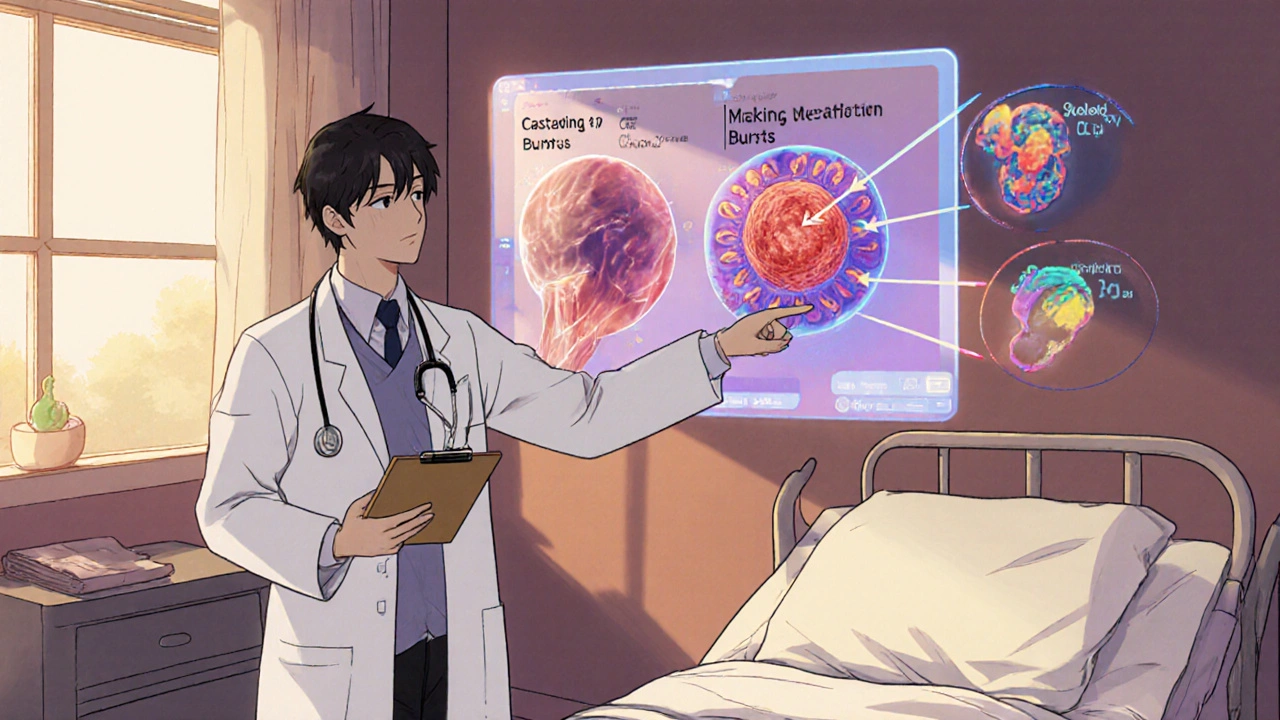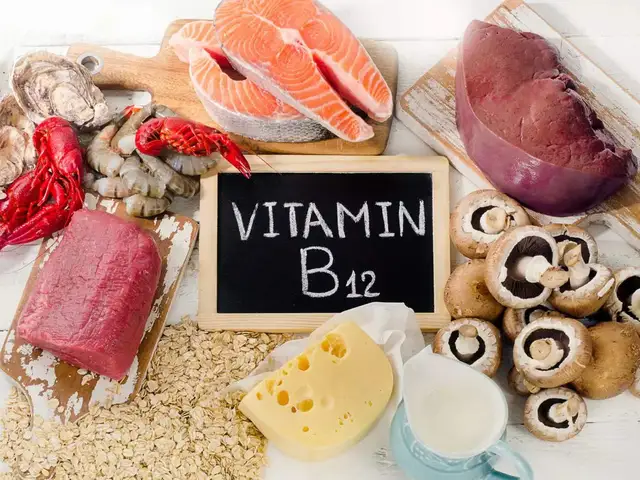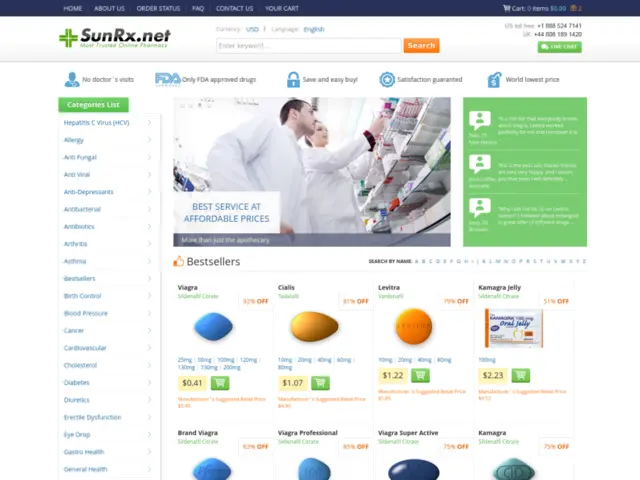Statin Myopathy Risk Assessment Tool
Assess Your Risk of Statin-Induced Muscle Symptoms
This tool estimates your risk of developing statin-induced myopathy based on factors discussed in the article. Results are for informational purposes only.
Millions of people take statins to lower cholesterol and protect their hearts. But for one in five, something unexpected happens: their muscles start to hurt, weaken, or cramp. This isn’t just a minor annoyance. It’s a real condition called statin-induced myopathy, and it’s one of the most common reasons people stop taking these life-saving drugs.
What Statin Myopathy Really Feels Like
If you’ve started a statin and suddenly feel like your legs are heavy, your calves cramp at night, or you can’t climb stairs like you used to, you’re not imagining it. These aren’t random aches. They’re symptoms of statin-associated muscle symptoms (SAMS), which affect 10% to 30% of users. For most, it’s mild-just a dull soreness that comes and goes. But for some, it’s severe enough to stop walking, sleeping, or even getting out of bed.
The timing matters too. Symptoms usually show up within the first six months. That’s when the drug has had time to build up in muscle tissue and start interfering with how cells work. The good news? If you stop taking the statin, symptoms often clear up in one to four weeks. That’s a key clue doctors use to confirm the diagnosis.
The Hidden Science Behind the Pain
For years, doctors thought statin muscle pain was just a side effect of unknown origin. But research since 2019 has uncovered three precise, interacting mechanisms that explain why this happens-specifically in skeletal muscle, not the heart.
The first and most damaging pathway involves calcium. Statins cause a protein called FKBP12 to detach from the ryanodine receptor (RyR1), a channel in muscle cells that controls calcium release. When FKBP12 pulls away, the channel leaks calcium uncontrollably. In human muscle biopsies, this leak increases by 2.3 times. That excess calcium triggers a chain reaction: it activates enzymes that break down muscle proteins and start cell death. This isn’t just inflammation-it’s programmed muscle cell suicide.
The second mechanism is about missing building blocks. Statins block the production of isoprenoids-farnesyl pyrophosphate and geranylgeranyl pyrophosphate-which are essential for attaching lipid anchors to proteins. Without these anchors, signaling proteins can’t stick to cell membranes properly. This disrupts muscle repair, growth, and communication. Studies show these compounds drop by 60% to 80% in muscle tissue after statin use.
The third is CoQ10 depletion. Statins reduce levels of coenzyme Q10, a vital molecule for energy production in mitochondria. After just four weeks of treatment, muscle CoQ10 drops by about 40%. That means your muscles can’t make energy efficiently. The result? Fatigue, weakness, and more oxidative stress-reactive oxygen species increase by 35% in affected tissue.
And then there’s the rare but serious autoimmune form. In 5% to 10% of persistent cases, the body starts making antibodies against HMG-CoA reductase-the very enzyme statins block. These anti-HMGCR antibodies attack muscle tissue directly. About 60% of people with this form had taken statins before. It’s not just a side effect-it’s an autoimmune disease triggered by the drug.

Why Some People Are More Affected Than Others
Not everyone on statins gets muscle pain. Why? Genetics, age, body size, and activity level all play a role. Older adults, especially women over 70, are at higher risk. People with kidney or liver issues, or those taking other medications like fibrates or certain antibiotics, are more vulnerable. But one of the biggest predictors? How active you are.
Studies show that people who maintain moderate exercise-150 minutes a week of brisk walking or cycling-have 58% fewer muscle symptoms than sedentary users. Why? Movement helps stabilize the RyR1 channel. In one study, rats on statins that had access to running wheels showed normal calcium control. Human trials confirmed it: 72% of active patients restored normal FKBP12 binding after eight weeks of exercise.
On the flip side, Reddit’s r/Statins community, with over 28,000 members, shows a clear pattern. In one major thread about atorvastatin-induced pain, 68% of respondents reported moderate to severe muscle discomfort within 30 days. Many described it as “like being punched in the legs every day.”
What Doctors Do When Muscle Pain Strikes
When a patient reports muscle symptoms, the first step isn’t to quit statins. It’s to confirm the link. Doctors will often ask the patient to stop the drug for four weeks. If symptoms fade, that’s strong evidence it’s statin-related. Then comes the rechallenge-trying a different statin or lowering the dose.
Rechallenge works about 40% of the time with a different statin, and 65% of the time with a lower dose. Rosuvastatin and fluvastatin tend to cause fewer muscle issues than simvastatin or atorvastatin. But if symptoms return, it’s time to consider alternatives.
CoQ10 supplementation at 200 mg per day has helped 35% of patients in clinical trials. Some doctors swear by it. Others say the evidence is mixed. But for those who try it, the difference can be real. One 2024 study found that combining CoQ10 with moderate exercise led to 80% symptom resolution-far better than either alone.
For those who can’t tolerate any statin, non-statin options exist. Ezetimibe lowers LDL by about 30% with almost no muscle side effects. PCSK9 inhibitors like evolocumab reduce LDL by 60% and have only a 3.7% muscle-related adverse event rate-lower than placebo in some trials. The catch? They cost about $5,850 a year, compared to $12 for generic atorvastatin.
And then there’s the autoimmune form. If anti-HMGCR antibodies are found, statins must be stopped permanently. Treatment involves immunosuppressants like methotrexate and prednisone. About 68% of patients go into remission within six months. But this is rare-only 0.02% of statin users.
What You Can Do Right Now
If you’re on a statin and feel muscle pain:
- Don’t stop cold turkey without talking to your doctor. Stopping suddenly can raise your heart attack risk.
- Track your symptoms: when they started, what hurts, how bad they are. This helps your doctor decide.
- Start moving. Walk 30 minutes five days a week. It’s not about intensity-it’s about consistency. Exercise helps stabilize the calcium channels.
- Ask about CoQ10. Take 200 mg daily. It’s safe, cheap, and worth a try.
- Get tested if symptoms persist. Ask for CK levels and, if needed, anti-HMGCR antibody testing.
- Discuss alternatives. Ezetimibe, bempedoic acid, or PCSK9 inhibitors may be options if statins aren’t working.
And if you’ve been told your pain is “just in your head” or “too common to worry about”-push back. Statin myopathy is real, measurable, and increasingly understood. You deserve care that matches the science.
The Bigger Picture
Statins save lives. In people with heart disease or high risk, they reduce heart attacks by up to 30%. But if muscle pain drives people off them, the benefit vanishes. A 2022 American Heart Association survey found that 31% of patients with muscle symptoms reduced their adherence, raising their cardiovascular risk by 25%.
That’s why the conversation is changing. Cardiologists now routinely discuss muscle risks before prescribing statins. The American College of Cardiology’s 2023 guidelines emphasize shared decision-making. It’s not about avoiding statins-it’s about finding the right fit.
And the future? Promising. A drug called S107, designed to lock RyR1 channels shut, reduced muscle symptoms by 52% in a 2023 trial. Two new statin candidates, STT-101 and STT-202, are in early testing and show 70% less muscle penetration while keeping liver effectiveness. If they work, they could bring statins back to millions who left them behind.
For now, the message is clear: muscle pain on statins isn’t normal, and it’s not something you have to live with. There are answers. There are options. And there’s science behind them.
Can statins cause permanent muscle damage?
In most cases, no. Muscle symptoms from statins are reversible. Once you stop the drug, symptoms usually improve within weeks. However, in the rare autoimmune form-anti-HMGCR myositis-muscle damage can be severe and long-lasting without proper treatment. This form requires immunosuppressive therapy and can lead to lasting weakness if not diagnosed early.
Does CoQ10 really help with statin muscle pain?
Evidence is mixed but encouraging. Clinical trials show about 35% of patients report symptom improvement with 200 mg of CoQ10 daily. The benefit seems strongest when combined with regular exercise. While not a cure, it’s a low-risk, low-cost option worth trying before switching medications. Some doctors recommend it as a first step for mild to moderate symptoms.
Can I take a lower dose of statin to avoid muscle pain?
Yes, and this works for many people. Studies show a 65% success rate when reducing the statin dose while maintaining some cholesterol-lowering benefit. Lower doses still reduce heart attack risk significantly, especially when paired with lifestyle changes. Talk to your doctor about switching to a lower strength or a different statin with fewer muscle side effects, like pravastatin or fluvastatin.
Is it safe to stop statins if I have muscle pain?
Don’t stop without medical advice. Statins reduce heart attack and stroke risk, especially in high-risk patients. Stopping suddenly can increase that risk by up to 25%, according to long-term studies. Instead, talk to your doctor. They can help you confirm if the pain is truly from the statin, and guide you through a safe plan-whether that’s switching, lowering the dose, or adding supplements.
Are there statins that don’t cause muscle pain?
Some statins are less likely to cause muscle issues. Pravastatin, fluvastatin, and rosuvastatin generally have lower rates of muscle-related side effects compared to simvastatin and atorvastatin. This is partly because of how they’re metabolized and how much enters muscle tissue. If you’ve had problems with one statin, switching to another may help. About 40% of patients tolerate a different statin after a previous reaction.
Can exercise make statin muscle pain worse?
No-exercise helps. Contrary to old advice, moderate physical activity doesn’t worsen statin myopathy. In fact, it improves it. A 2023 JUPITER trial subanalysis found exercisers had 32% lower creatine kinase levels and 41% fewer symptoms than sedentary users. Exercise helps restore calcium control in muscle cells. Aim for 150 minutes a week of brisk walking, cycling, or swimming. It’s one of the most effective, free interventions available.
What are the alternatives to statins for lowering cholesterol?
Several non-statin options exist. Ezetimibe lowers LDL by about 20-30% with minimal muscle side effects. Bempedoic acid reduces LDL by 20-25% and is approved for statin-intolerant patients. PCSK9 inhibitors like evolocumab and alirocumab lower LDL by up to 60% and have very low muscle adverse event rates (3.7% vs. 5.1% for placebo). These are injectables and more expensive, but they’re effective and safe for those who can’t take statins.





Herbert Scheffknecht - 20 November 2025
So we're just supposed to believe that a cholesterol drug is secretly turning our muscles into leaky calcium sieves while starving them of energy and repair tools? That's not medicine, that's a biological betrayal. And the real kicker? The same companies that sell you statins are the ones funding the "CoQ10 doesn't work" studies. Wake up. This isn't side effects-it's systemic sabotage disguised as science.
Jessica Engelhardt - 22 November 2025
Statins are just big pharma’s way of turning healthy people into patients. I don’t need some pill to fix what my grandpa fixed with beans and walking. Also why are we even talking about this like it’s a new discovery? My grandma took statins in 2005 and said her legs felt like wet cement. Nobody listened then either.
Martin Rodrigue - 22 November 2025
The mechanistic data presented regarding FKBP12-RyR1 dissociation and isoprenoid depletion is methodologically sound and aligns with recent findings in muscle bioenergetics. However, the clinical translation of CoQ10 supplementation remains equivocal due to heterogeneous bioavailability and lack of standardized dosing protocols across trials. One must also consider pharmacogenomic variability in SLCO1B1 expression, which significantly modulates statin myopathy risk.
Sherri Naslund - 22 November 2025
ok but like... why does everyone act like this is some new secret? my cousin went on atorvastatin and couldnt even lift her coffee cup. she cried in the grocery store because her legs were so weak. and the dr just said "oh its common" like its a bad hair day. i swear if you dont have money for a pcsk9 inhibitor you just get told to suck it up and take your poison pill. this system is broken.
Abdula'aziz Muhammad Nasir - 24 November 2025
Thank you for this well-structured overview. Many patients are unaware that muscle symptoms are not merely "in their head"-the biochemical pathways are now well-documented. For those in low-resource settings, exercise remains the most accessible intervention. Even 20 minutes of daily walking can stabilize RyR1 channels. CoQ10 is worth trying, but don’t replace medical supervision with supplements. Always consult your provider before discontinuing statins, especially if you have established cardiovascular disease.
Tara Stelluti - 25 November 2025
I knew it. I KNEW IT. They told me it was "just aging" and "I’m too sensitive." But I had the exact same symptoms. I stopped the statin. Two weeks later I could walk up stairs again. My doctor said "it was probably placebo" but I know better. This is the first time anyone’s explained WHY it happened. I feel seen.
Danielle Mazur - 26 November 2025
Let’s be honest-this is all part of the Great Pharmaceutical Control Agenda. The calcium leak? The CoQ10 depletion? These are engineered side effects to keep people dependent. Why do you think they don’t fund research into natural alternatives? Why is ezetimibe so expensive? Why is exercise never mentioned in drug ads? They want you weak, docile, and buying pills forever. The FDA is complicit. The NIH is compromised. Wake up.
Margaret Wilson - 27 November 2025
so like... i tried coq10. it was like magic. i could finally carry my groceries again. i cried. i was so happy. i told my doctor and she said "meh, placebo" but i dont care. i’m not going back to feeling like a zombie with lead legs. thank you for writing this. i’m sending it to my whole family. 💪❤️
william volcoff - 27 November 2025
Interesting how the article mentions exercise stabilizes RyR1, yet most guidelines still recommend rest during muscle pain. That’s outdated. The rat studies are clear-movement restores channel binding. Also, the 65% success rate with dose reduction? That’s huge. Why isn’t this the first-line recommendation instead of switching drugs? And CoQ10? At 200mg, it’s cheaper than my daily coffee. Why are we still debating this?
Freddy Lopez - 28 November 2025
There’s a deeper truth here: medicine has become a system of symptom management rather than root cause resolution. Statins mask cholesterol; they don’t heal the vessel. And when they break the muscle, we’re told to endure it as the price of survival. But what if survival isn’t just about living longer-but living well? Maybe the real question isn’t whether to take statins, but whether we’ve built a healthcare system that values human function over lab numbers.
Brad Samuels - 29 November 2025
I’ve been on statins for 8 years. Had mild cramps for a while, but I kept going because I didn’t want a heart attack. Then I started walking 30 minutes every day-just slow, no fancy gear. After three weeks, the cramps were half as bad. I asked my doc about CoQ10 and she actually listened. I’m on 200mg now. I still take the statin, but I don’t feel like I’m being eaten from the inside anymore. This post? It’s the first time I felt like someone actually gets it.